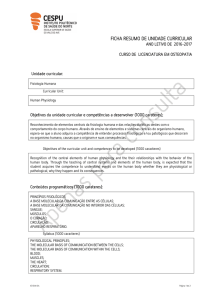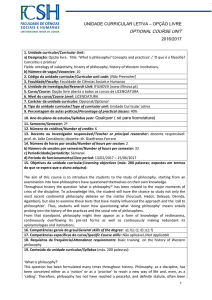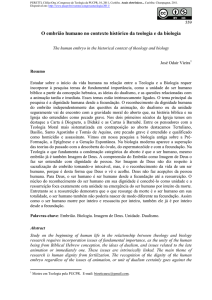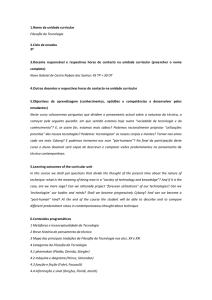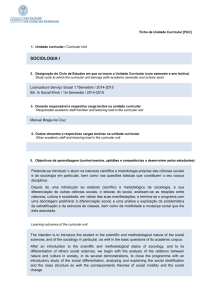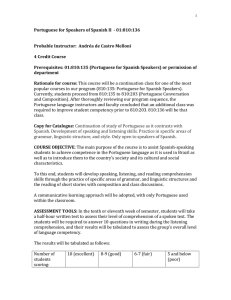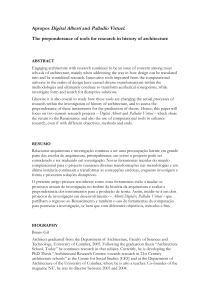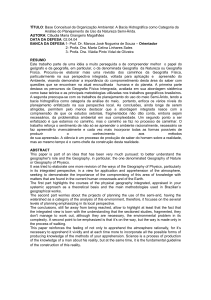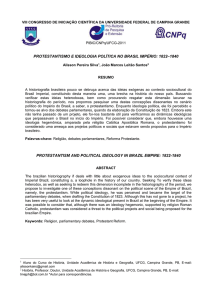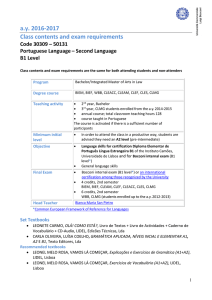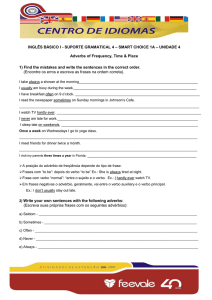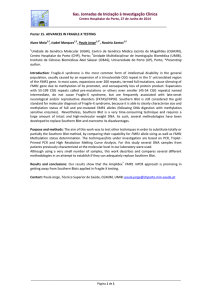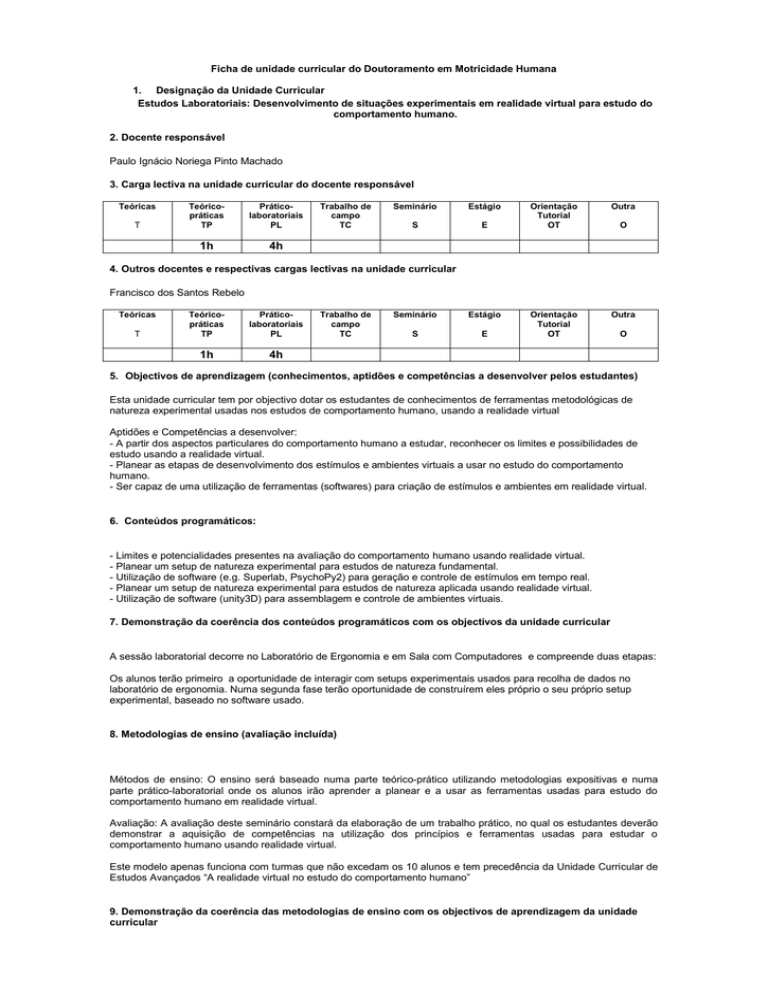
Ficha de unidade curricular do Doutoramento em Motricidade Humana
1. Designação da Unidade Curricular
Estudos Laboratoriais: Desenvolvimento de situações experimentais em realidade virtual para estudo do
comportamento humano.
2. Docente responsável
Paulo Ignácio Noriega Pinto Machado
3. Carga lectiva na unidade curricular do docente responsável
Teóricas
T
Teóricopráticas
TP
Práticolaboratoriais
PL
1h
4h
Trabalho de
campo
TC
Seminário
Estágio
S
E
Orientação
Tutorial
OT
Outra
Orientação
Tutorial
OT
Outra
O
4. Outros docentes e respectivas cargas lectivas na unidade curricular
Francisco dos Santos Rebelo
Teóricas
T
Teóricopráticas
TP
Práticolaboratoriais
PL
1h
4h
Trabalho de
campo
TC
Seminário
Estágio
S
E
O
5. Objectivos de aprendizagem (conhecimentos, aptidões e competências a desenvolver pelos estudantes)
Esta unidade curricular tem por objectivo dotar os estudantes de conhecimentos de ferramentas metodológicas de
natureza experimental usadas nos estudos de comportamento humano, usando a realidade virtual
Aptidões e Competências a desenvolver:
- A partir dos aspectos particulares do comportamento humano a estudar, reconhecer os limites e possibilidades de
estudo usando a realidade virtual.
- Planear as etapas de desenvolvimento dos estímulos e ambientes virtuais a usar no estudo do comportamento
humano.
- Ser capaz de uma utilização de ferramentas (softwares) para criação de estímulos e ambientes em realidade virtual.
6. Conteúdos programáticos:
- Limites e potencialidades presentes na avaliação do comportamento humano usando realidade virtual.
- Planear um setup de natureza experimental para estudos de natureza fundamental.
- Utilização de software (e.g. Superlab, PsychoPy2) para geração e controle de estímulos em tempo real.
- Planear um setup de natureza experimental para estudos de natureza aplicada usando realidade virtual.
- Utilização de software (unity3D) para assemblagem e controle de ambientes virtuais.
7. Demonstração da coerência dos conteúdos programáticos com os objectivos da unidade curricular
A sessão laboratorial decorre no Laboratório de Ergonomia e em Sala com Computadores e compreende duas etapas:
Os alunos terão primeiro a oportunidade de interagir com setups experimentais usados para recolha de dados no
laboratório de ergonomia. Numa segunda fase terão oportunidade de construírem eles próprio o seu próprio setup
experimental, baseado no software usado.
8. Metodologias de ensino (avaliação incluída)
Métodos de ensino: O ensino será baseado numa parte teórico-prático utilizando metodologias expositivas e numa
parte prático-laboratorial onde os alunos irão aprender a planear e a usar as ferramentas usadas para estudo do
comportamento humano em realidade virtual.
Avaliação: A avaliação deste seminário constará da elaboração de um trabalho prático, no qual os estudantes deverão
demonstrar a aquisição de competências na utilização dos princípios e ferramentas usadas para estudar o
comportamento humano usando realidade virtual.
Este modelo apenas funciona com turmas que não excedam os 10 alunos e tem precedência da Unidade Curricular de
Estudos Avançados “A realidade virtual no estudo do comportamento humano”
9. Demonstração da coerência das metodologias de ensino com os objectivos de aprendizagem da unidade
curricular
No âmbito da Unidade Curricular Estudos Laboratoriais, pretende-se com estes conteúdos, proporcionar aos alunos do
cursos de Doutoramento em Ciências da Motricidade e Ciências da Educação, uma perspetiva e prática do estudo do
comportamento humano, utilizando ferramentas de simulação, através do desenvolvimento de ambientes virtuais.
Estas ferramentas enquanto enquadrada com metodologias adequadas, permitem contornar as limitações éticas,
económicas, de replicabilidade e dificuldade de controlo de variáveis associadas às metodologias tradicionais.
10. Bibliografia Principal
Cedrus (2014). SuperLab Manual. Cedrus Corporation, San Pedro, California, United States. Online in www.cedrus.com
Creighton, R.H. (2010). Unity 3D Game Development by Example. Packt Publishing. Birmingham, UK.
Peirce, J.W. (2015) PsychoPy, Psychology software in Python, Reference Manual (API). Version Online in
http://www.psychopy.org/api/api.html. Consulted in November, 20th, 2015.
Peirce, J.W. (2009). Generating stimuli for neuroscience using PsychoPy. Frontiers in Neuroinformatics, 2: 10.
doi:10.3389/neuro.11.010.2008
Peirce, JW (2007). PsychoPy - psychophysics software in Python. Journal of Neuroscience Methods 162:8-13
Rebelo, F., Noriega, P., Duarte, E. & Soares, M. (2013) Using virtual reality to assess user experience. Human Factors, 54(6),
964-982. (IF: 1.182)
http://hfs.sagepub.com/content/54/6/964.full
Vicenzi, D.A., Wise, J.A., Mouloua, M., & Hancock, P.A. (2009) Human Factors in Simulation and Training. CRC Press:
Boca Raton, FL, United States.
Vilar, E., Rebelo, F. Noriega, P. Duarte, E. & Mayhorn, CB. (2014). Effects of competing environmental variables and signage
on route-choices in simulated everyday and emergency wayfinding situations. Ergonomics, 57 (4), 511-524. (IF: 1.608)
http://www.tandfonline.com/doi/abs/10.1080/00140139.2014.895054#.VH2tX9YeT5Y
Vilar, E., Rebelo, F., Noriega, P., Teles, J. & Mayhorn, CB. (2013). The influence of environmental features on route selection
in an emergency situation. Applied Ergonomics. 44 (4). 618-627. (IF: 1.332)
http://www.sciencedirect.com/science/article/pii/S0003687012001925
Sheet Curricular Unit
2.
Curricular Unit Name
Laboratory Studies: Development of experimental situations using virtual reality for human behavior studies
2. Teacher in charge (fill in full name)
Paulo Ignácio Noriega Pinto Machado
3. Teaching load in the curricular unit of the teacher in charge
Theoretical
T
Theoretical
and
practical
TP
Pratical-Lab
1h
4h
Field Work
PL
TC
Seminar
Internship
Tutorial
Other
S
E
OT
O
Seminar
Internship
Tutorial
Other
S
E
OT
O
4. Other teachers and their teaching loads in the curricular unit
Francisco dos Santos rebelo
Theoretical
T
Theoretical
and
practical
TP
Pratical-Lab
1h
4h
Field Work
PL
TC
5. Learning objectives (knowledge, skills and competencies to be developed by students)
This course aims to provide students with knowledge of methodological tools of experimental nature used in studies of
human behavior, using virtual reality
Skills and competencies to be developed:
- Starting from the particular aspects of human behavior to study, recognize the limits and possibilities using virtual
reality.
- Planning the development stages of the stimuli and virtual environments to use in the study of human behavior.
- Be capable of using tools (software) for creating virtual reality stimuli and environments.
6. Programme contents
- Limits and today potentiality of using virtual reality in the evaluation of human behavior.
- Planning a setup of an experimental nature for fundamental studies.
- Software use (eg SuperLab, PsychoPy2) for generation and control of stimuli in real time.
- Planning a setup of an experimental nature for applied studies using virtual reality.
- Software use (Unity3D) for assembly and control of virtual environments.
7. Demonstration of consistency of program contents with the objectives of the course
The laboratory session held at the Ergonomics Laboratory and in a classroom with computers and comprises two
steps:
Students will first have the opportunity to interact with experimental setups used for data collection in the ergonomics
laboratory. In a second phase they will have the opportunity to build they own their own experimental setup, based on
the software learned.
8. Teaching methods (including assessment)
Teaching methods: The teaching will be based on a theoretical and practical part using expository methodologies and a
practical part and laboratory where students will learn to plan and use the tools used to study human behavior in virtual
reality.
The evaluation of the seminar will include the development of a practical work, in which students will demonstrate the
acquisition of skills in the use of the principles and tools used to study human behavior using virtual reality.
This model only works with groups of no more than 10 students and have precedence of the Course for Advanced
Studies "Virtual reality in the study of human behavior"
9. Demonstration of consistency of teaching methods with the learning objectives of the course
Within the Curriculum Unity “Laboratory Studies”, with these contents it is intended, provide students of the PhD courses
in Science of Motricity and Educational Sciences, a perspective and practice of the study of human behavior, using
simulation tools, through the development of virtual environments. These tools, when integrated with the appropriated
methodologies, allow circumvent the limitations of ethical nature, economic, replicability and control of variables,
associated with traditional methodologies.
10. Principal Bibliography
Cedrus (2014). SuperLab Manual. Cedrus Corporation, San Pedro, California, United States. Online in www.cedrus.com
Creighton, R.H. (2010). Unity 3D Game Development by Example. Packt Publishing. Birmingham, UK.
Peirce, J.W. (2015) PsychoPy, Psychology software in Python, Reference Manual (API). Version Online in
http://www.psychopy.org/api/api.html. Consulted in November, 20th, 2015.
Peirce, J.W. (2009). Generating stimuli for neuroscience using PsychoPy. Frontiers in Neuroinformatics, 2: 10.
doi:10.3389/neuro.11.010.2008
Peirce, JW (2007). PsychoPy - psychophysics software in Python. Journal of Neuroscience Methods 162:8-13
Rebelo, F., Noriega, P., Duarte, E. & Soares, M. (2013) Using virtual reality to assess user experience. Human Factors, 54(6),
964-982.
(IF:
1.182)
http://hfs.sagepub.com/content/54/6/964.full
Vicenzi, D.A., Wise, J.A., Mouloua, M., & Hancock, P.A. (2009) Human Factors in Simulation and Training. CRC Press:
Boca Raton, FL, United States.
Vilar, E., Rebelo, F. Noriega, P. Duarte, E. & Mayhorn, CB. (2014). Effects of competing environmental variables and signage
on route-choices in simulated everyday and emergency wayfinding situations. Ergonomics, 57 (4), 511-524. (IF: 1.608)
http://www.tandfonline.com/doi/abs/10.1080/00140139.2014.895054#.VH2tX9YeT5Y
Vilar, E., Rebelo, F., Noriega, P., Teles, J. & Mayhorn, CB. (2013). The influence of environmental features on route selection in
an emergency situation. Applied Ergonomics. 44 (4). 618-627. (IF: 1.332)
http://www.sciencedirect.com/science/article/pii/S0003687012001925

